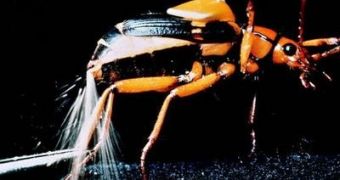The chemical war is far from being invented by people. It has been employed for over 100 Ma by the bombardier beetles, over 500 species, included in the Carabidae family - tribes Brachinini, Paussini, Ozaenini, or Metriini. They can fire a mixture of chemicals from special glands in their posterior. The beetles use a pair of deflectors located in the tip of their abdomen and they can point a jet of hot toxic chemicals with high precision towards a possible predator (from ants to birds and frogs), "shooting" it in a fraction of a second up to a distance of 20 cm (8 in).
These beetles are now helping improve the spray technology for engines, drug-delivery devices and fire extinguishers, as presented by a new research published in the "Physics World."
The chemistry of the process has been known for some time. Bombardier beetles store two chemicals (hydroquinone and hydrogen peroxide) which are mixed in a "combustion chamber" only when they are attacked. These chemicals are released through two tubes, together with catalytic enzymes (catalases and peroxidases), resulting a violent heat-releasing chemical reaction, with the final product p-quinones (especially the toxic benzoquinone).
The hot foul-smelling liquid turns 20% into a gas, causing a loud popping sound. The shot is deadly to insects and other small animals and painful to human skin. As these beetles are immune to p-quinones, they can also defend themselves by splashing it over their body parts, like the back, when attacked by groups of small insects, such as ants. The shots can be repeated 12 times, but after that the beetle needs one hour to recover its "bomb" supply. The new research has decoded the mechanism of this chemical defense: it's in the combustion chamber's inlet and exit valves. The inlet valve allows the entrance of the chemicals, which start boiling as soon as they meet, and closes when enough gas has entered. The reacting gases produce heat, boosting the pressure inside the closed chamber.
When the pressure value has reached a critical point, the exit valve is forced, and the toxic fluid is fired in a "flash evaporation". After the fluid release, the exit valve closes, the inlet valve opens, and when the chamber is once again filled, the next shot is fired.
The team at the School of Process, Environmental and Materials Engineering at Leeds University, led by Andy McIntosh, replicated this mechanism employing only water, and managed to achieve shots of hot spray up to 4 m (13 ft) away, with a great control of the size of the droplets. The new technology has been licensed by the Swedish Biomimetics 3000 Ltd company.
It could make an improved drug-delivery system compared to the mechanically-driven spring technology employed in inhalers, and also an energy-saving mechanism for fuel-injection in car engines. Fire extinguishers using this technology could control the size of the droplets, delivering from a fine mist to large droplets, adjusted to the type of the fire to be extinguished.

 14 DAY TRIAL //
14 DAY TRIAL //